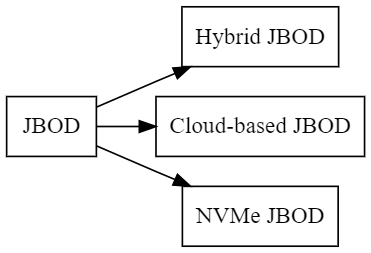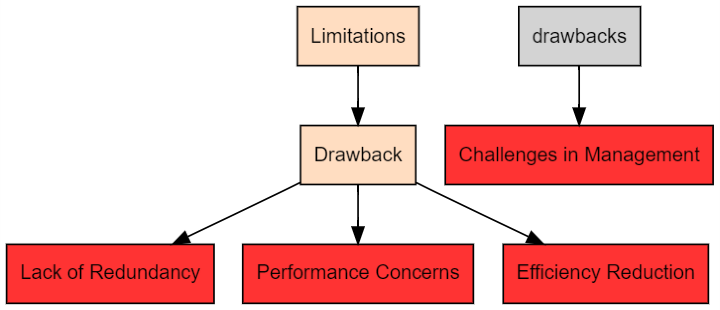
 Data Structure
Data Structure Networking
Networking RDBMS
RDBMS Operating System
Operating System Java
Java MS Excel
MS Excel iOS
iOS HTML
HTML CSS
CSS Android
Android Python
Python C Programming
C Programming C++
C++ C#
C# MongoDB
MongoDB MySQL
MySQL Javascript
Javascript PHP
PHP
- Selected Reading
- UPSC IAS Exams Notes
- Developer's Best Practices
- Questions and Answers
- Effective Resume Writing
- HR Interview Questions
- Computer Glossary
- Who is Who
Overview of Just a Bunch Of Disks (JBOD)
Introduction
Whenever we deal with the data storage can often feel frustrating, especially as files grow in size and our need for required space expands. Did you happen to know that there is a simple storage solution called 'Just a Bunch Of Disks' or JBOD that might be what your system needs? This article will guide you through an overview of JBOD, helping to clarify its benefits and when it may be suggested to prefer over other configurations for example, RAID.
What is JBOD?
The option for data storage, JBOD, short for "Just a Bunch Of Disks," refers like an architecture where multiple independent hard disk drives are compiled together into a single unit. This specific setup allows each and every drive to operate independently within the collective structure.
It's crucial to mention that in contrast with RAID storage devices, these drives don't need to be same size. What happens using this configuration is known as disk aggregation or spanning, primarily merging many smaller drives into a larger virtual one.
The main focus of this distinct storage architecture is maximizing available storage capacity rather than offering redundancy or improving performance like other configurations such as RAID (Redundant Array of Independent Disks).
Data stored on a JBOD array encompasses across all disks without any form of redundant data backups; hence, if a singular drive fails within the system, only information stored on that particular unit will be vanished or lost.
Advantages
JBOD is a low-cost storage solution as it doesn't require any additional hardware or any complex configurations.
It allows for easy scalability, as you can simply add more drives to that array without having to reconfigure the whole system.
Each drive in JBOD operates independently, that means if one drive fails, it won't affect the any other drive present in the array.
JBOD presents maximum utilization of storage capacity, as it combines all the drives into a single logical volume unit.
It provides flexibility in terms of data placement and retrieval, as you can choose where to store specific files or folders within the array.
It is compatible with different operating systems and file systems, making it versatile and easy to integrate into existing setups.
It allows for efficient use of various types or sizes of drives in the same parent array, providing options for customization based on your specific needs.
JBOD vs. RAID
There is a common and prevalent confusion among data storage enthusiasts and professionals alike - the debate between JBOD and RAID. Each one has its own unique merits and demerits. It is important to understand their specific features and compare them head-to-head to make an informed choice.
Attributes |
JBOD |
RAID |
|---|---|---|
Definition |
It is straightforward storage architecture that put together multiple drives into a single large volume. |
It is a storage technology that distributes data across multiple drives for enhanced speed and data protection. |
Data Protection |
It provides limited data protection as each drive operates independently. |
It provides data redundancy and fault tolerance through mirroring or parity. |
Speed |
This depends on the individual drive's performance. |
RAID can significantly improve read/write speeds, depending on the RAID level used. |
Capacity |
JBOD is full use of all installed drives' capacity. |
It uses some disk capacity for redundancy, leading to a lower usable storage capacity. |
Ease of Implementation |
It is easier to set up and manage due to its simplicity. |
Its Setup and management can be complex, requiring a certain level of expertise. |
Remember, the choice between JBOD and RAID is not one-size-fits-all and greatly depends on your particular needs and circumstances.
Recent advances and future
JBOD has been an affordable solution to maximize storage capacity but without redundancy for data protection compared with other configurations like RAID. However, as technology progresses, new advancements in JBOD have emerged that can improve its performance and capabilities even further.

Hybrid JBOD
To make sure of an optimum performance, an effective solution that involves an integration of both HDD and SSD technologies. By relying on HDD for long term data retention and SSD for high-speed access to frequently visited files or applications users can enjoy fast read write rates without sacrificing memory capacity.
Cloud-based JBOD
Cloud-based JBOD is another innovation that leverages cloud computing technology by creating a distributed network of drives across multiple locations. This means that data can be accessed from any device that is connected to the cloud, improving accessibility, mobility, and productivity.
NVMe JBOD
Additionally, if you desire a swift storage option that can meet the growing demand of big data while ensuring efficiency and reliability then consider NVMe JBOD. This advanced alternative utilizes Non Volatile Memory Express (NVMe) technology providing a faster read write speeds than both traditional hard drives as well as SSDs. Companies dealing with extensive volumes of information - including those driven by AI - can count on this innovative tool to deliver optimal results.
Limitations
One viable option for those seeking alternative storage solutions is JBOD; however, users should consider both the benefits and potential drawbacks before approaching to this configuration.

While affordability and flexibility both are attractive features of this method it lacks key safeguards such as built in redundancy protocols or fault tolerance software.
Lack of redundancy is one major drawback and because of this, any loss of performance from even one drive in the setup could result in irretrievable loss of data across the entire array. Companies looking for reliable data protection should consider other configurations like RAID or hybrid RAID/JBOD solutions in comparison to the JBOD.
Its performance is also a matter of concern, and it relies entirely on individual drives' capabilities within the array. Because of this, slower drives can bring down the entire system's read-write speeds, resulting in bottlenecking and poor overall performance.
In addition to the above, mixing different-sized disks within a single JBOD volume can also reduce efficiency. If you mix large capacity disks with small capacity disks, for instance, you'll end up wasting space while limiting overall capacity to match the smallest disk's size.
Lastly, managing JBOD arrays can involve more challenges compared with RAID due to its lack of advanced features like automatic data rebuilds after a drive failure. Therefore, when it comes to the selection you must have sufficient expertise on backups and disaster recovery protocols. Also, monitoring and maintaining each drive's health in an array can become a complex process.
Conclusion
JBOD is a storage architecture that allows for the independent use of several disk drives without any data redundancy or multilevel configuration. It provides a cost-effective solution for organizations with large storage capacity needs but does not offer the same level of data protection as RAID.
The readers of this article can benefit from understanding JBOD's advantages, disadvantages and differences from RAID when considering their storage solutions.
while Just a Bunch Of Disks (JBOD) offers simplicity, cost-effectiveness, scalability, and flexibility in terms of storage configurations, it is not the best solution for businesses with high-capacity storage needs that require data redundancy or advanced features like automatic rebuilds and backups. Hence users must assess their specific needs carefully and consider all factors before choosing JBOD as their preferred storage solution.
FAQs
1. What is JBOD and how does it work?
JBOD (Just a Bunch Of Disks) is a storage configuration that allows multiple hard drives to be combined into a single logical unit. Unlike its close competitor RAID configurations, JBOD does not provide data redundancy or performance enhancements. Each drive in the JBOD array operates independently, resulting in increased storage capacity but without the protection against data loss.
2. What are the advantages of using JBOD?
Using JBOD can be advantageous if you require maximum storage capacity at a comparatively lower cost. It also offers flexibility since each drive can be easily replaced or upgraded without affecting other drives in the array.
3. Can I use different-sized drives in a JBOD setup?
Yes, you can use different-sized drives in a JBOD setup only but keep in mind that the total usable capacity will be limited by the size of the smallest drive in the array.
4. Is data protection possible with JBOD?
Unfortunately, No! The data protection is not inherent to JBOD setups because there is no redundancy built into this configuration. If one drive fails, it can result in complete data loss for that particular drive's content unless proper backups have been made separately.

